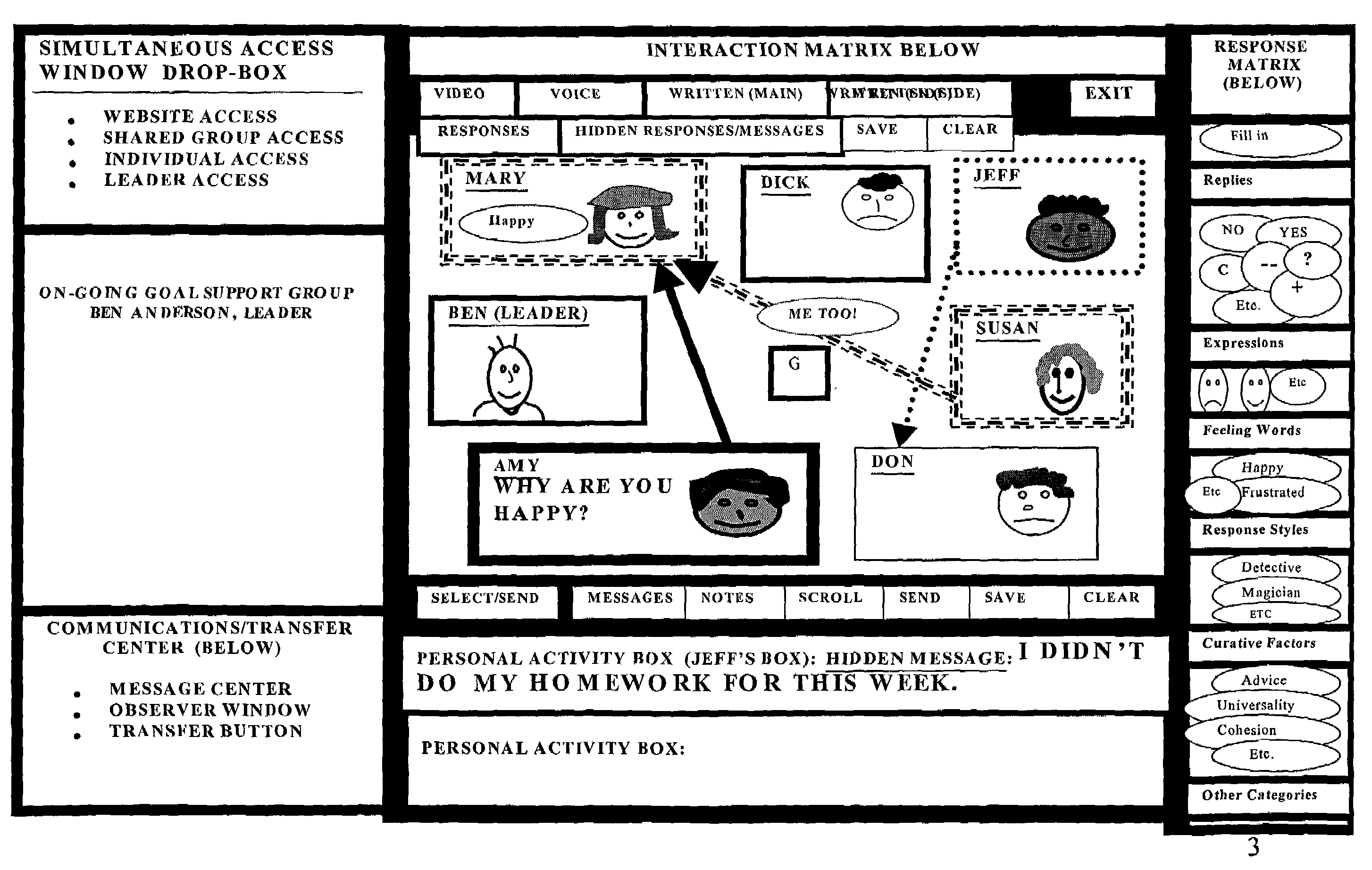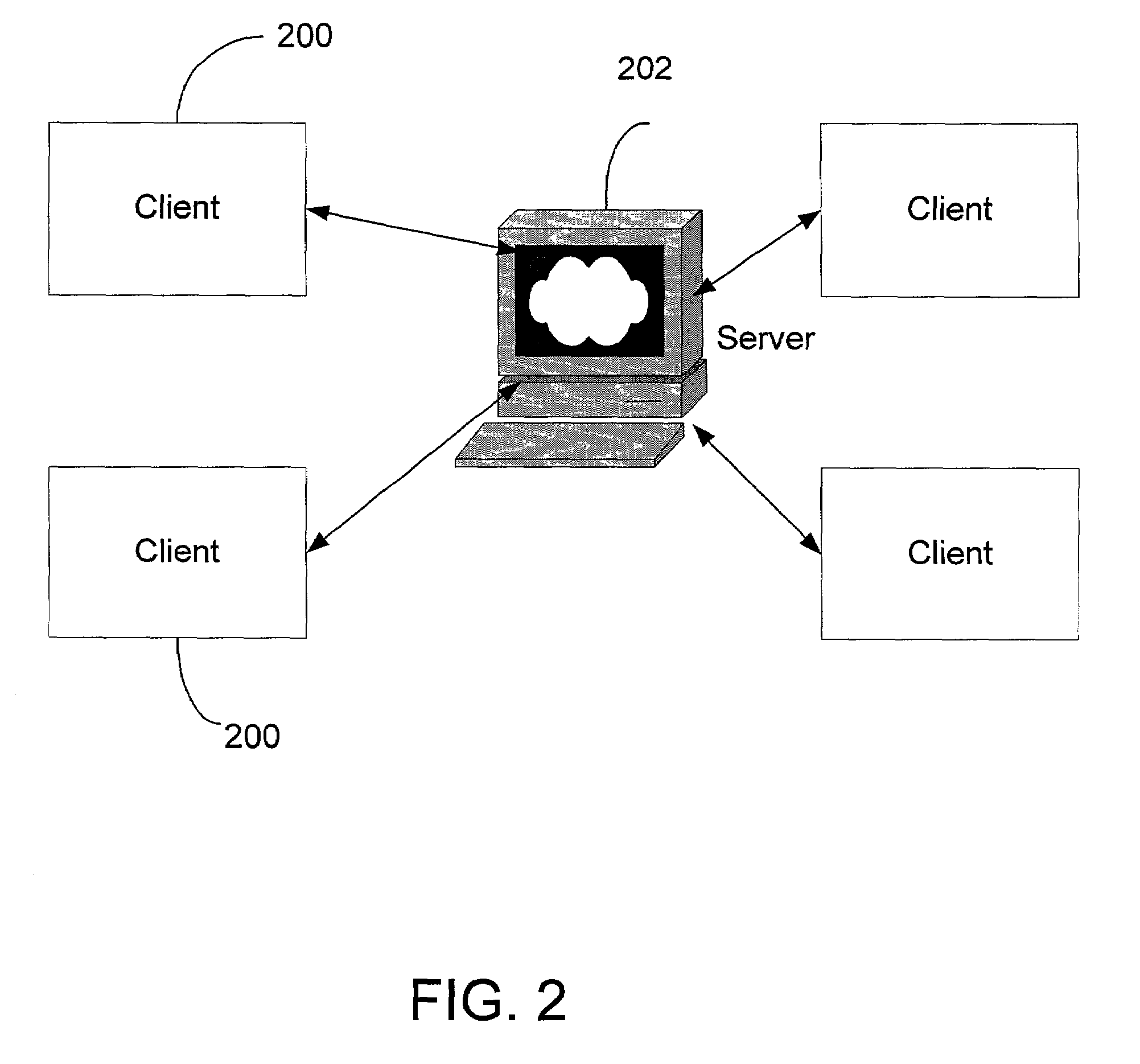Problems with Existing Systems of Computerized Group Interaction
There are many problems associated with currently available systems of computerized group interaction.
Generally speaking, conventional systems for group interaction (e.g. chat-rooms) are poor replicas of actual communication in the real world.
They are even poorer imitations of the operation of functional, task-oriented groups.
The main problem with currently available systems of computerized group interaction is that they do not provide a no way of visualizing all members of the group with whom one is interacting at the same time.
In chat-rooms, it is difficult to ascertain these things.
Another problem with these systems is that communications must usually occur in a serial manner, one entry at a time, even though this is not the way natural communication in the real world occurs.
Another problem with currently available systems is that they do not allow for a new person to join a closed membership meeting that is already in progress (at the discretion of the “gatekeeper”) as often happens in real-life situations.
Another problem with currently available systems is that most do not provide the capacity to view presentation materials at the same time that the group communication is going on.
Another problem with these systems is that specially developed clinical tools for teaching group
communication skills (or enhanced work team skills) cannot be utilized during the course of the group meeting.
Another problem with currently available systems of computerized group interaction is that they do not allow group members to rate themselves and each other on questions relevant to their progress on goals or their group participation.
Another problem with these systems is that they make no provision for taking notes or “minutes” while participating in the meeting.
This is a serious limitation, as usually someone is asked to take notes during meetings and then is required to type them out for later
dissemination or
record-keeping.
Another problem with currently available systems of computerized group interaction is that there is no way to transfer confidential work documents or reports between group participants.
Another problem is that it is not possible to reserve a meeting room for on-going work on a large project that requires intermittent attention from different participants over an extended period of time.
Another problem with currently available systems is that they do not follow a standardized format across different programs, thereby making voice, video, and written communication between groups of people difficult if not impossible at times. This is exactly the same problem that sometimes exists when people with different
internet service providers (ISPs) or
instant messaging services try to communicate, especially by voice.
Yet another problem with these systems is that they do not allow the user to move pieces of written information from place to place during the interaction.
A final problem is that current systems of electronic group interaction do not allow people outside of the group room to observe the meeting.
People learn a lot via “observational learning”, and space may not always be available for the numbers of people who want to participate.
In addition to the above-described problems with conventional computerized group
interaction systems, there are serious problems associated with electronic group discussions in a more general sense.
They include a) Students are quickly overwhelmed by too much information that is not organized; b) Students do not have good group
communication skills.
Unfortunately, most existing websites for discussion groups (or support groups) do not provide adequate organization of material, nor do they provide appropriate opportunities for learning group
communication skills.
Clearly, the opportunity to observe another group in action is not an option on existing websites.
Despite the effectiveness of various types of exercises as aids to improving group skills, computerized discussion groups are currently unable to employ these methods.
However, there is currently no available
system of group interaction that allows for obtaining these types of ratings,
activity level data, and feedback in groups meeting via global communications networks.
While there is one
web site that allows people to form their own closed groups (a company called e-groups), this
web site does not provide the necessary structure and guidance to help group members follow through with any of these methods for strengthening group cohesion.
Additionally, the e-groups site suffers from all of the limitations of computerized group interaction outlined above.
In view of the above-described limitations of computerized group interaction and of computerized group discussions in general, current internet group communication is often shallow, unstructured and ineffective.
However, the existing web sites that provide group services and structured programs over
the internet suffer from all of the same limitations of
group communication systems over computer networks that were outlined above.
In addition, no current system of
group system delivery provides a way to meet all of the requirements for providing structured group programs outlined in this section.
There are many limitations associated with the kinds of groups that are offered to the general public both in the “real world” and on
the internet.
One main limitation is that there is no group program, either in the real world or on
the internet, that is focussed specifically on helping the general
population reach their personal goals.
Still others do not have the finances to go to professional group therapy sessions, nor the time or the transportation to
commit to
community support groups.
Some people may not know what they want; others may want too much.
Some people may not know how to go about attaining their goals, while others know exactly what they need to do, but cannot bring themselves to do it.
Still other people have a
solid understanding of what they would like to accomplish, but are unable to locate the resources needed to actualize their goals.
But there is currently no place where relatively “healthy” people can meet together to get the support and structure that they need to help them reach their personal goals.
The greater frequency of meetings involving more and more people has led to higher travel and office space costs (to allow for conference rooms), as well as decreased productivity of some workers.
While there are sites for groups to meet over the internet (e.g., e-groups and voicechat), these sites suffer from many of the limitations of computerized group
interaction systems outlined above.
Specifically, these systems do not allow users to “see” the participants with whom they are interacting or to share on-line program materials with them.
While expensive teamware and
virtual office systems are available for use over computerized networks, these systems also suffer from many of the limitations of computerized group
interaction systems outlined above.
Existing teleconferencing systems provide an enhanced way for some meetings to occur electronically, but they generally do not allow for sharing documents while at the same time viewing the other participants involved in the meetings.
But chat-rooms and
instant messaging services also suffer from the limitations of computerized group interaction systems outlined above.
 Login to View More
Login to View More  Login to View More
Login to View More 


